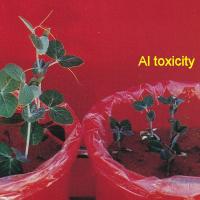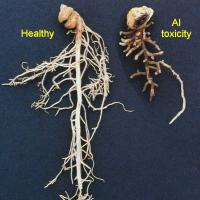Diagnosing soil acidity in field peas
Soil acidity overwhemingly causes aluminium toxicity in Western Australia. Field peas are sensitive, but few problems have been diagnosed because they are mostly grown on alkaline heavy-textured soils.
What to look for
- Molybdenum is less available, and pea rhizobia persist poorly in acidic soils. Both problems cause nodulation failure.
Paddock
- Small to stunted plants with stunted roots.
- Oldest and middle leaves develop large cream coloured necrotic patches.
- Growth and yield varies with soil type,usually worse on acidic sandier soils.
Plant
What else could it be
| Condition | Similarities | Differences |
|---|---|---|
| Diagnosing potassium deficiency in field peas | Older leaf pale necrosis; sandier soils worse | Roots normal; Pinkish pale necrotic spots |
| Diagnosing zinc deficiency in field peas | Older leaf pale necrosis. | Plants are less stunted have more inter-plant variability; roots are not stunted. |
| Diagnosing boron toxicity in field peas | Older leaf pale necrosis. | Occurs on heavy highly alkaline soils; roots are not stunted. |
| Diagnosing group C herbicide damage in field peas | Older leaf pale necrosis. | Affects seedlings; roots are not stunted. |
Where does it occur?
- There are two main categories of acid soils in WA:
- Soils where acidification from agriculture is affecting production.
- Soils that were naturally highly acidic before agriculture: 'Acid wodjil' soils in the east/north-east wheatbelt and acid peaty soils in the south- west.
- Soil acidification occurs naturally very slowly as soil is weathered but is accelerated by productive agriculture.
- Soil acidifies because the concentration of hydrogen ions in the soil increases.
- In WA the two main causes of soil acidification are inefficient use of nitrogen and export of food and fibre from the farm
Management strategies

Lime application
- Liming is the most economical method to ameliorate soil acidity in soils that are suitable for field peas. The amount of lime required will depend on the soil pH profile, lime quality, soil type, farming system and rainfall.
How can it be monitored?

Soil test
- Select sites according to the main soil types in a paddock, accurately identify the location and resample areas at risk every four years.
- On sandy duplex soils, sampling 0-10, 10-20 and 20-30 cm soil layers is necessary to detect topsoil and subsurface soil acidity. A 5 cm diameter exhaust tube, marked in 10 cm increments, is a suitable tool.
- Plant tissue testing is of no value for diagnosing aluminium toxicity, as associated root pruning causes reduces uptake of all nutrients.
See also
Further information
Where to go for expert help
Page last updated: Friday, 29 May 2015 - 2:03pm




